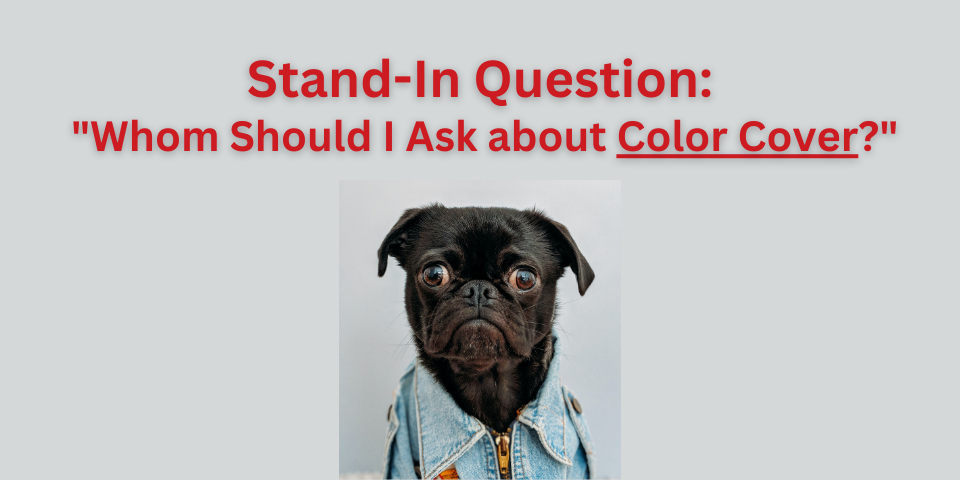If you’ve ever worked as a stand-in on a TV show or film, you may be familiar with the term “color cover.”
The term “color cover” refers to an item of clothing you wear or the production provides to you that typically resembles the color or pattern of clothing your actor is wearing in the scene.
A production may have you wear color cover if its director of photography (DP) requests it. For some DPs, stand-ins’ wearing color cover helps in better lighting and composing a shot. Other DPs don’t seem to care much about color cover and can light stand-ins without needing them to wear color cover.
Given that color-cover requirements vary from production to production (and even from DP to DP), it’s no wonder that a stand-in may have questions when it comes to color cover.
So, the next question is: Whom should the stand-in ask about color cover?
Let’s dive in!
The Casting Director
Chances are, a casting director has lined you up for stand-in work. If you have the ability to text or chat with this casting director, you can ask whether or not production wants you to wear color cover. If so, then you might follow up by asking what to wear for color cover.
If you have no guidance from casting about what to wear as color cover, in general, stick to neutral tones, dark colors, and solids, staying away from bright colors or busy patterns. This is a decent rule of thumb, unless of course you have good reason to go against it. (If you’re working on a Barbie film, it might be better to come in pink!)
The Background PA
In the event casting gives you no guidance about color cover, when you arrive at holding or on set, ask the background PA whether you need color cover. If you do, the background PA may direct you to the wardrobe department or the wardrobe trailer in order to get color cover. Make sure you know the character for whom you’re standing in — you may need to share it with wardrobe in order for them to pull an appropriate garment for you.
Sometimes, rather than having to visit wardrobe, either wardrobe or a PA will hand-deliver color cover for you on set. Once you get it, feel free to put it on. If you’re standing in the moment they’re giving it to you, try to put it on right then.
There’s typically no need to strip down to put on color cover — it’s usually just a top or a jacket. Put it over top your current clothing. If it’s too small, possibly wear it around your neck or simply ask for something a little larger. (Color cover is infamously ill-fitted, so if it’s too big, you might not have much room to complain!)
An AD
If you report to set rather than to holding, you might not see a background PA. In that event, you can ask an assistant director if production requires color cover. Between the 1st AD and the 2nd 2nd AD (both of whom you may see on set), opt to ask the 2nd 2nd AD as this AD will probably be more able to respond to your question.
Regular Stand-Ins
If the production has regular stand-ins, they may also be advisors on whether production has its stand-ins wear color cover. Keep in mind, regular stand-ins are not authorities on the matter — they just may be helpful in understanding production’s typical expectations.
Other Methods
Of course, you can find other ways to figure out color cover for a day. If you know someone in the wardrobe department and have a friendly relationship, you can text for some guidance on what to wear before coming to work. You might even get sent a photo of what you might want to match.
If you are working multiple days on a production standing in for the same character, keeping track of the script days (“D1,” “D2,” etc.) may guide you on what wardrobe you might expect your actor to wear in the scenes on a future work day. For example, if your actor wore a blue jacket on the first day you stood in, and the scene was a D2 scene in the script, and if you return later in the week for the actor and production is still shooting D2 scenes, you might guess accurately to wear color cover matching that character’s D2 look from the first day you worked. You might be right, you might not be, but it’s typically a decent guess.
Similarly, if you know regular stand-ins on the production, you might check with them in advance of the work, to see if they have any guidance on color cover or the script days your actor is involved in.
The Social Effects of Wearing Color Cover
When you appear on set as a stand-in wearing color cover that resembles your actor, it tends to reflect professionalism and commands a little more respect. If that’s your interest when standing in, then take some steps upon booking a stand-in job to figure out the color cover for the day. It may lead to a production wanting to having you around on set more often!
Who else might you ask about color cover when standing in? Share your advice in the comments below!







Leave A Comment